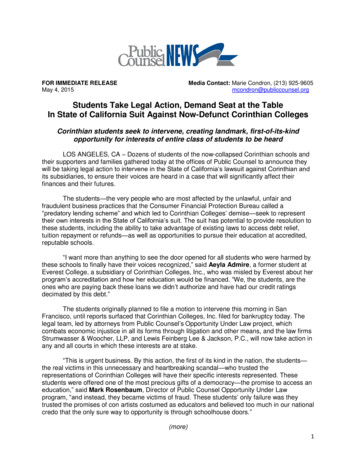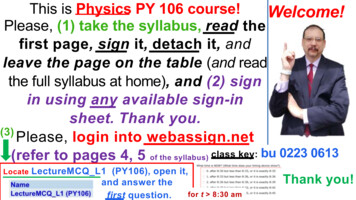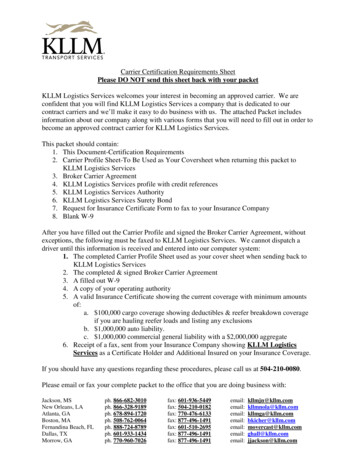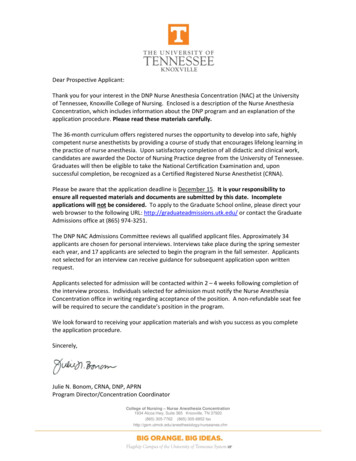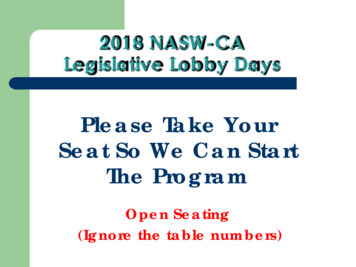
Transcription
2018 NASW-CALegislative Lobby DaysPlease Take YourSeat So We Can StartThe ProgramOpen Seating(Ignore the table numbers)
2018 Lobby Days Speaker Director of Government Relationsand Political Affairs for NASW-CAFormer Outreach Coordinator for theCalifornia Budget & Policy CenterChief-of-Staff to formerAssemblymember AntonioVillaraigosaSenior Legislative Assistant to formerMajority Floor Leader Tom HanniganFormer Consultant with the Speaker’sOffice of Majority Services underthen Speaker Willie BrownFormer Organizer at UCB for theCalifornia Public Interest ResearchGroup (CalPIRG)Rebecca Gonzales
Regional Directors A-EShelly Kalmer (A)Glenn Thomas (B)Erica Feldman (C)Tracy Harrison (D)Stephen Fallie (E)
Regional Directors (F-I)Leslie Wind (F)Jose Ramos (G)Shulli Lotan (H)Rosamarie Alamo (I)
Lobby Days Objectives Learn about priority legislation thataffects social workers and their clientsMeet Legislators and other importantpolitical contactsNetwork with social workers and “standup for others” on important social policyissues
Lobby Days IssuesAB 186 (Eggman)Safer Substance Use ServicesSB 10 (Hertzberg)Bail ReformSB 982 (Mitchell)CalWORKs Grants
How Are TopicsDetermined? Current or Emerging Issues Member Submissions Positions Based On “Social Work Speaks” NASW-CA Legislative Committee NASW-CA Board Approval
Attendee ObjectiveLearn as much aboutthe policy issuespresented and howthey apply to you andyour clients
2018 Lobby Days Speaker Student Director South BSW, Class of 2018, CSULA Social Work Intern, Victims ofCrime Program, Los AngelesCounty District Attorney’s Office Focus on social justice,gerontological social work andadequate services for homelesspopulationsAlicia Saravia
2018 Lobby Days Speaker Student Director North BSW, Class of 2015, SJSU MSW, Class of 2018, CSUEB Title IV-E Intern, Santa Clara CountyDepartment of Family and Children’sServices Recipient of SJSU First GenerationScholarship, CSUEB’s Asian and PacificIslander Faculty and Staff Assoc.Scholarship, and CSUEB’s AssociatedStudents’ Merit-Based ScholarshipTherese Gonzales, BSW
University Role CallAlicia Saravia, Student Director SouthTherese Gonzales, Student Director NorthAzusa PacificCSU BakersfieldCSU Dominguez HillsCSU FullertonCSU Long BeachCSU Los AngelesCSU San BernardinoCSU San DiegoCSU San MarcosCal Baptist UniversityLa Sierra UniversityLoma Linda UniversityUCLAUSCWhittierCSU ChicoCSU East BayCSU FresnoCSU Monterey BayCSU, NorthridgeCSU StanislausCSU HumboldtCSU SacramentoCSU San FranciscoCSU San JoseUC BerkeleyFresno PacificOnline studentsProfessional Social Workers
Unity Cheer!On the count of 3,let’s join in a cheerto bring eachsocial workertogether in unityand strength!
2018 Lobby Days Speaker Executive Director of the 10,000member California Chapter ofNASW, the largest NASW Chapterin the U.S.Serves on the Board of Directors forthe California Social WorkEducation Center, and on theNASW Presidential DiversityInitiativeFormer San Diego County ChiefAdministrative Staff Officer, PublicConservator and Chief of AdultProtective Services in San DiegoReceived his MSW from SanFrancisco State University and a BAin Asian Studies from ClaremontMcKenna CollegeJanlee Wong, MSW
2018 Lobby Days Speaker Director of Research, CaliforniaBudget & Policy CenterFormer researcher, TomasRivera Policy Institute,Consumers Union, and thePublic Policy Clinic at theUniversity of Texas at AustinCalifornia Executive FellowFormer newspaper reporterPh.D. in political science,University of Texas at AustinBachelor's degree ingovernment and journalismfrom CSU SacramentoScott Graves, Ph.D
2018 Lobby Days Speaker Currently serves as LegislativeDirector for AssemblymemberSusan Talamantes Eggman Joined AssemblymemberEggman’s staff as an MSW intern Previously served as a mentalhealth counselor for youth inresidential and school settings. Serves on the leadership ofNASW-Sacramento Unit Graduated with his MSW fromCSU Sacramento in 2016.Logan Hess, MSW
Assembly Bill 186 (Eggman)Supervised Consumption Services Pilot Programmegan.eddy@asm.ca.gov
The opioid crisis In 2011, drug overdose overtook car accidentsas the number one cause of accidental death.Drug overdose is the leading cause of death forAmericans under 50.Over the past 5 years, the opioid crisis hascontributed to the tripling of new Hepatitis Ccases.Hospitals in CA treat an overdose every 45minutes.Someone dies of overdose every 90 minutes inCA.
What are Safe InjectionSites, or SupervisedConsumption Services? Sterile, healthcare facilitiessupervised by medicalprofessionals.Provide access to steriledrug consumptionequipment.Provide access to andreferrals for drugtreatment, medicationassisted treatment,medical care, socialservices, and more.Provide the life-savingoverdose reversal drugnaloxone.
What does the bill do?AB 186 allows localgovernments within sixcounties the opportunityto establish SupervisedConsumption Servicepilot programs until2022. The programswould have to meetcriteria laid out by the billand collect data.
Insite - Vancouver (2016)
Why should we try this?Despite the controversy aroundSCS, they have been around fordecades. They have beenrigorously studied and the researchshows they: Increase referrals to andengagement in treatment. Eliminate overdose deathsonsite and reduce them in thesurrounding area. Save millions of dollars incriminal justice and healthcarecosts Reduce syringe litter andpublic injections
These programs do not:What they don’t do. Increase crime ordrug use in theareaIncrease thenumber of peoplewho use drugsIncrease relapserates or violence
AB 186 is currently on the Senate Floor Will need 21 votes to pass, received19 in September. The Assembly will have to concur inSenate amendments with 41 votes. The Governor needs to sign into law.
Applying the CRTPerspective to SaferSubstance Use ServicesCalifornia State University, Dominguez Hills
How many of you know what CRT is?
Critical Race Theory CRT is an interdisciplinary theoretical framework thatchallenges individuals to address intersecting forms ofoppression It is a way of looking at our social work profession andunderstanding that there are historical, institutional,intergenerational, and societal systems of oppressionthat impact how people interact with each other
Importance of a CRT Lens as Social Workers To advance social justice ideas to the general public, andscholars, while also aiming to even out social inequalities Study the intersections between different marginalized groups.Recognizing that race and racism work with and throughgender, ethnicity, class, sexuality and/or nation as systems ofpower Study the significance of mass media and popular culture inthe distribution of power and the perception of vulnerablepopulations
Applying CRT to AB186Social Construction Race, class, gender, sexual identity, and other socialidentities are products of social thought and relations. They are not objective, inherent, or fixed. They correspond to no biological or genetic reality;rather, races are categories that society invents,manipulates, or retires when convenient.
What my friends told me drug users look like:
What my parents told me drug users look like:
What society thinks drug users look like:
What drug users actually look like:
Applying CRT to AB186Intersectionality No person has a single, easily stated, unitary identity Points to the multidimensionality of oppressions and recognizesthat race alone cannot account for disempowermentVoices of Color The “storytelling” movement urges oppressed groups torecount their experiences and challenge the dominant narrative
Applying CRT to AB186Interest Convergence When the dominant groups’ interests align with the marginalizedgroups’ needs or demandsEx: The dominant group will support social justice only when theyperceive that there is something in it for them. Coming from a school that is integrating CRT, we have to considerthat AB186 possibly originates from an interest convergence ofdominant interests lining up with marginalized individuals.
NASW Core Values“Everyone perceives me as a criminal,as an addict, as worthless, and nothingmore not as a human being that Iam.” - anonymous
2018 Lobby Days Speaker Director of Membership for NASWCA Adjunct Part-time faculty forCalifornia State University,Dominguez Hills MSW Program Clinical specialty ismaternal/perinatal mental health(also a birth doula) Former Psychiatric Social Worker forLos Angeles County Department ofMental Health (outpatient andMen's Jail Mental Health Services) Graduated from the UCLA MSWProgram - Go Bruins!S. Jolene Hui, MSW, LCSW
NASW is Here forYou, from Campus toCareerS. Jolene Hui, MSW, LCSWNASW-CA Director of MembershipLegislative Lobby Days 2018Sacramento, CA38
NASW is your professional association.LARGESTGROUP 5 LOCALCHAPTERS Largest organizationof professional socialworkers 120,000 members 17,000 studentmembers 55 local chapters –one in each state,plus US territory andinternationalchapters
NASW’S MISSIONThe primary mission of the social workprofession is to enhance humanwell-being and help meet the basic needs of allpeople, with particularattention to the needs of those who arevulnerable, oppressed andliving in poverty.
NASW CODE OF ETHICS
What do we offer?ProfessionalDevelopmentAdvocacyMembershipIn cEducationProfessionalBenefits &ServicesOnlineContinuingEducation
Joining NASW as a student benefits you throughoutyour career. News and informationAdvocacy effortsCareer resourcesTraining and education Ethics and legal guidance Practice resources Malpractice insurance Building a professional network
Networking Region A:Shelly Kalmer Region B:Glenn Thomas Region C:Erica Feldman Region D:Tracy Harrison Region E:Stephen Faille Region F:Leslie Wind Region G:Jose Ramos Region H:Shuli Lotan Region I:Rosemary Alamo
From campus to career, NASW is here tohelp you succeedS. Jolene Hui, MSW, LCSWDirector of kers.org/join.asphttp://www.naswca.orgFacebook: wcaTwitter: @nasw; @naswca; @naswca advocacy
List of Websites on.orgwww.helpstartshere.org
Scholarships Gosnell:http://www.naswfoundation.org/gosnell.asp Mackey and other NASW Foundationscholarships Asian Pacific Islander Social Work Council Native AmericanBirdwoman:http://www.naswca.org/?page NativeAmericanApp
Student MembershipBSW and MSW Student Membership Dues Annually 57After Graduation: 150 Years 1 & 2, 170, Year 3.75% membership discount for student membersUp to 807/ 954 in dues savings for BSW to MSW with continuous student membershipEligible NASW transitional members may apply for discounted professional liabilityinsurance for the first two years of professional practice.
GET A FREE NASW-CAWATER BOTTLE!When you sign up as a member today!Limited Supply – so visit us now!
VISIT US AT THEMEMBERSHIP TABLEWe are raffling off items such asSocial Work Month t-shirts and In-n-Out Giftcards tothose who sign up today!After you sign up you can meet yourRegional Director!The Regional Director table is located nextto the membership table in the exhibit area.Also, stop by the NASW-CA Council tablelocated in the same area to learn aboutcouncils you can join!
2018 NASW-CALegislative Lobby DaysWhat you can do during the break: Join NASW if you are not a memberBid at the CalPACE Silent Auction tableVisit the Exhibitor Area
2018 Key Note Speaker Raised in Turlock and served in the U.S. Army,where she was trained as a combat medic. Worked in substance abuse counseling andhospice care Former Assoc. Professor of Social Work andSocial Research, CSU Sacramento Founding member, Central Valley StonewallDemocratic Club Two-term member of the Stockton City Counciland steered the city through fiscal crisis. FirstLatina elected to that office and first out LGBTcandidate elected in the Central Valley Elected Nov. 2012 to represent the13th Assembly District. Chair of theAccountability & Administrative ReviewCommittee Author of the End of Life Option ActSusan Talamantes EggmanMSW, LCSW, PhD
CalPACE In our current political climate, it is crucialthat we defend marginalized communities.CalPACE is a non-partisan political actioncommittee formed to elect social workcandidates and candidates that supportsocial work values.Campaigns cost money. Every dollar raisedwill help elect candidates that will fightharmful immigration policies and other issuesof concern. Contributions are voluntary.
Lunch Explanation Box lunches will be provided outside ofthe ballroom. Please exit through theback and return to the lobby to pick upyour lunch. Return through the side doors.If your ordered a vegetarian/veganlunch, hand your ticket to the attendantat the corresponding table.Feel free to eat outside if you wish buttake your belongings with you.
Networking BreakPlease Return toBallroom at 1:15!
Stretch for Social Justice!Reach down to get power from your grass rootsReach up to the sky for inspirationStamp out social injusticeMove with the winds of change
2018 Lobby Days Speaker Legislative Attorney for the American CivilLiberties Union of California Center forAdvocacy and Policy. Works to reform California’s criminal justicesystem, including pretrial systems, civil assetforfeiture, interrogation recordation, pretrialdiversion, and postconviction procedure. Works to defeat regressive criminal justicepolicies that disproportionately impactcommunities of color and low-incomecommunities, or erode constitutional rights. Previously worked as a staff attorney at thePost Conviction Assistance Center in LosAngeles, and as an investigator at theSouthern Center for Human Rights in Atlanta,Georgia. BA in American Culture from the University ofMichigan; JD from the UCLA School of Law.Mica Doctoroff
CALIFORNIA BAIL REFORM ACT OF2017SB 10M I C A D O C TO R O F FAC L U O F C A L I F O R N I A C E N T E R F O R A DVO C AC Y A N D P O L I C Y
BAIL 101HistoricalPurposeToday’sPurposeBail process inCANonfinancialReleaseMoney Bail Getting people to return to court Return to court Public safety ArrestBookingBail scheduleArraignment Own recognizance Own recognizance with additional conditions Pay full amount and get it back if you showup to court Pay a (10%) non-refundable fee for acommercial bail bond
WHY BAIL REFORM?Peoplewhoreliesare ondetained Californiapretrial pretrialdetentionare:at higherEconomicDisparityratesthan the restof the United States. 25% more likely to plead guilty to a crime. Thebailratesamountin Californiais 50,000 – 5 times the national medianEvenmedianwith highof detention,California( 10,000). Unableparticipatein rates,theiranddefense.has had higherfailure-to-appearRacialtoDisparityhigher rates of felony rearrests. Whenpleadasked whethercould affordan emergencyexpense costing just Mayguilty theyto crimestheydid not commit. 400, 46% of American adults said they could either not cover the expense,wouldto coveritDefendantsbyandsellingor borrowing money. ngnotPoorOutcomesprotect public safety. Nationally, people who are unable to meet bail fall within the poorest third ofsociety.Poor Public Policy Median per capita income for California is 31,733 – nearly 20,000 less thanthe median bail.
6 CORE FUNCTIONS OF SB 10Eliminates the use of bail schedules bothpre-arraignment and once a person goesbefore a judge.Minimizes the use of money bail, andrequires that money bail be set only in anamount a person can pay.Limits pretrial detention only to peoplewho pose a serious risk of physicallyinjuring someone if released.Requires courts to utilize the leastrestrictive option for release, with apresumption of release without conditions.Creates pretrial services agencies toassist people who have been releasedpretrial.Limits and regulates the use of riskassessment tools.
SB 10/AB 42 – LEGISLATIVE STATUSSB 10AB 42 Introduction Senate Public Safety Committee:passed Senate Appropriations: passed Senate Floor: passed Assembly Public Safety: passed Current Status: AssemblyAppropriations Introduction Assembly Public Safety Committee:passed Assembly Appropriations: passed Assembly Floor: failed Current Status: Dead
ARGUMENTS IN SUPPORT The time for bail reform is now:– Governor, the Chief Justice, the Attorney General have all come out in support forbail reform and want to get it done soon.– The California Court of Appeal recently ruled that California’s bail practices areunconstitutional and called on the legislature to act. Our current money bail system is not fair:– Today, the amount of money in your pocket determines whether you will get out ofjail.– Many people cannot afford even 10% of the full amount – and if they can, they areoften choosing between getting out of jail and making sure their family has enoughmoney to survive.– Families that are able to scrape together enough money to pay a bail agent oftenend up in debt for years. Our current money bail system is not safe:– Today, wealthy people are able to bail out of jail even if they pose a serious risk ofinjuring another person if released.– Right now, someone can be arrested for domestic violence, pay bail, and be backhome within hours.
ARGUMENTS IN SUPPORT SB 10 will make our communities safer:– Under SB 10, certain people (including people charged with a serious orviolent felony, or domestic violence) will have to wait to see a judge beforethey can be considered for release.– Arrestees will be assessed for risk to the public through the use of a riskassessment tool designed to provide an objective assessment of likelihoodof appearing in court and not compromising public safety.– Through the provision of pretrial services, courts will have the option ofreleasing defendants with individually tailored conditions and servicesspecifically designed to protect the public and the victim.– Courts will have the option of denying release to felony arrestees, if theperson poses a serious risk of physically injuring someone if released. SB 10 is different from AB 42:– While AB 42 and SB 10 started out as identical bills, SB 10 has beenamended multiple times since the Assembly voted on AB 42.– The amendments have addressed some of the concerns raised by DistrictAttorneys, the Judicial Council, the Counties, and Probation.
RESPONSES TO COMMON QUESTIONS/CONCERNSQ:Where is the bill right now?A: In Assembly Appropriations.Q: I was waiting on the Chief Justice’s pretrial work group to conclude itswork.A: The Chief Justice’s pretrial work group issued its report andrecommendations in October. Their findings and recommendations werelargely in line with SB 10, and the Chief Justice has made it clear she wantslegislation to move forward as soon as possible.Q: What is the status of the negotiations?A: Conversations with the authors, the Governor’s office, law enforcement, thejudges, the Counties, and the sponsors are ongoing. One of the sponsorswill follow up with you.Q: Where is law enforcement on this?A: The Attorney General – the chief law enforcement agent of the state –supports bail reform and has vowed to work with the Legislature, theGovernor. The Sheriffs’ Association and the Chief Probation Officers havenot taken a position. There have been ongoing conversations with theDistrict Attorneys Association as well as individual DAs.
RESPONSES TO COMMON QUESTIONS/CONCERNS (cont .)Q: I am concerned about victims and survivors of domestic violence. Won’tthis bill let danger
BSW, Class of 2018, CSULA Social Work Intern, Victims of Crime Program, Los Angeles County District Attorney’s Office Focus on social justice, gerontological social work and
